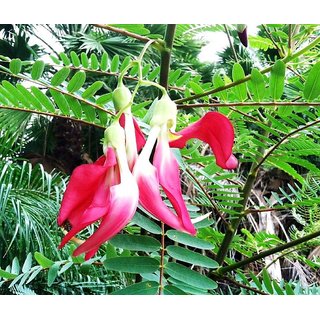
Agastya (Sesbania grandiflora) –
- April 28, 2016
- Posted by Vaidya Jagjit Singh
- 0 Comment(s)
Ayurvedic Properties & Medicinal Usage
Table of Contents
INTRODUCTION
Sesbane plants are found almost everywhere. It grows well in areas which are abundant in water and have hot climate. During rainy season, the scattered seeds start germinating. As per Rajnighantu, sesbane has four varieties; white yellow, blue and red flowered. White flowered plants are most common of all the four. Parts of the plant like soft leaves, flowers and fruits are cooked and eaten.
APPEARANCE
Sesbane trees grow very fast but have a shorter life. Trees are 15 ft tall. Leaves are in bunches of 20-25 pairs arranged on a long thin spine. Each leaf is 1-1 ½ inch long, oval in shape. Flowers are white in colour and boat shaped. The fruits are 1 ft in length, slightly curved, and flat. Each fruit has 14-19 light colored seeds.
PROPERTIES
Sesbane tree parts are cool and bitter, they are beneficial in curing pitta kapha quartan fever, and dry cough. They also cure gastric disorders and cold. Flowers have a cooling effect, are mildly, and are mildly bitter, astringent, and pungent. They help cure rib disorders, fever, night- blindness, and many other diseases. Leaves are bitter but also mildly sweet, hard to digest, and slightly warm, they are beneficial in curing warm kapha, blood disorders, and cold. Fruits are bitter sweet and laxative. They enhance palate, intelligence, and memory. They cure disorders of the three humours, jaundice, depression, and stomach diseases.
MEDICINAL USAGE
Epilepsy:-
- Take equal quantities of sesbane leaf powder and black pepper. Grind them with cow urine. Let the patient inhale this mixture.
- In case patient is a child, take extract of 1 sesbane leaves and mix half the quantity of black pepper in it. Dip a cotton flock in this mixture and place near the child nostril. It brings immediate relief.
Migraine:-
Based on the side of the brain which is aching, drops 1-3 drops of sesbane leaf extract or flower extract on the opposite nostril. This brings immediate relief from headache as well as any pain I the nostrils.
Cold:-
In case of heaviness or headache due to cold, drop 1-4 drops of sesbane leaf extract in the nostrils. 10-156 gm of sesbane root extract with honey. 2-4 times a day, may be taken.
Eye problems:-
- 1 drops of sesbane flower extract in eyes. It clears the blurred vision.
- Cook its flowers as dish in the meals, morning and evening. It cures night blindness.
- Take 200 gm of sesbane leaves. Grind them and cook them in 1 kg medicated ghee. Give 4-9 gm of this ghee to the patient every morn-ing and evening. It is extremely beneficial in curing eye problems.
- Put a few drops of honey which exude out of the sesbane flowers. It helps cure blurred vision. When the flowers are plucked, 1-3 drops of honey exudes out of it.
- Roast the flowers in ghee and take it regularly. It helps cure blurredness of vision and other eye problems.
Delusion:-
Take sesbane leaf extract and mix equal quantities of ginger root, peeper and jiggery. Give 1-2 drops for inhalation.
Dryness and cough related problems:-
Prepare sesbane leaf decoction. Use it for gargles. It cures dry cough, scaling of tongue and helps release of cough. Also beneficial in curing husfy voice.
Abdominal/ Stomach pain:-
In 15 gm decoction of sesbane bark, add a little amount of rock salt and 18 roasted cloves. Give this mixture to the patient every morning and evening. Within 2 days it cures all types of abdominal illness and pain.
White leucorrhea:-
Take fresh bark and grind it to extract its juice. Take a piece of cotton and soak it in the bark juice and then place it in the vaginal area. It gives relief in white leucorrhea and also relieves in itching.
Arthritis:-
Take dhatura root and sesbane root in equal quantities and grind them. Prepare a and tie it on the aching area. It cures the pain and reduces the swelling. In case of lesser pain, apply paste of red sesbane root.
Gout:-
Take dried flowers and grind them to from a fine powder. Mix 99 gm powder in 1 litre of buffalo milk and ferment it to form curd. Next day prepare butter from the curd and use this butter for massage.

Vaidya Jagjit Singh is a 3rd generation Ayurved physician from his family and is the remarkable person responsible for setting up of the Chandigarh Ayurved and Panchkarma Centre in sector 32 and 22, Chandigarh and Zirakpur and he is also the first founder member of Guru Ravidas Ayurved University. He has done his B.A.M.S. from Shri Dhanwantri Ayurvedic College, Chandigarh. He is an admirable ayurvedic physician with specialization in Chronic ailments.

